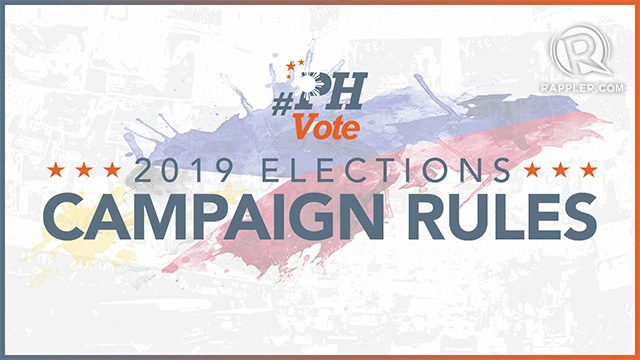SUMMARY
This is AI generated summarization, which may have errors. For context, always refer to the full article.

MANILA, Philippines – Public places, media outlets, and social media are teeming with campaign ads of candidates for the May 13, 2019, national and local elections.
They are all bound by campaign rules, as set by the Commission on Elections (Comelec). These rules for the 2019 polls are stated in Comelec Resolution 10488, in line with the Fair Elections Act.
Here’s a guide for voters as well as poll watchers on what candidates should follow during the 2019 campaign period.
When is the election campaign period?
For national candidates, or those running for senator and party list, the campaign period is from February 12 to May 11. (READ: What to expect as the 2019 campaign period for national bets begins)
For local candidates, from House representatives to city and municipal councilors, they can campaign from March 29 to May 11.
Campaigning is not allowed on Maundy Thursday (April 18), Good Friday (April 19), the eve of election day (May 12), and on election day (May 13).
How much can bets spend during the campaign period?
Candidates who belong to a political party can spend P3 per registered voter covered by the elective position they are running for.
Meanwhile, independent bets can spend P5 per voter. Political parties and party-list groups can also spend P5 per voter.
What campaign materials are allowed during the campaign period?
- Pamphlets, leaflets, cards, decals, stickers, or similar materials (maximum width: 8 1/2 inches; maximum length: 14 inches)
- Handwritten or printed letters campaigning for or against a candidate/party
- Posters, whether framed or posted (maximum area: 2 feet by 3 feet)
- Banners or streamers during public meetings or rallies which may only be displayed from 5 days before up to 24 hours after the rally (maximum area: 3 feet by 8 feet)
- Social media posts, whether original or reposted, which may be incidental to the creator’s advocacies of social issues or is primarily endorsing a candidate
- Mobile units, vehicles, or motorcades of all types
- Paid ads in broadcast, internet, mobile, print, or outdoor media
- Campaign materials (except banners or streamers) in headquarters and residences of candidates
Comelec encourages the use of recyclable and environment-friendly materials in campaign paraphernalia.
What must be included in campaign materials?
All forms of campaign ads must contain the following information in readable or audible formats:
“Political advertisement paid for”
(Candidate’s name, his/her address)
“Political advertisement paid by”
(Payor’s name, his/her address)
Campaign ads donated or given free of charge must contain the information below. Free or donated ads must have written acceptance of the candidate/party.
“Printed free of charge by”
(Donor’s name, his/her/its address)
“Airtime for this broadcast was provided free of charge by”
(Donor’s name, his/her/its address)
How much airtime are given to candidates?
National candidates and parties may air only a total of 120 minutes of TV ads per station and 180 minutes of radio ads per station.
Local candidates may air only a total of 60 minutes of TV ads per station and 90 minutes of radio ads per station.
In ads with multiple candidates, each bet will share the airtime and campaign expenditure based on their appearance on the ad.
How big should campaign ads be in newspapers?
Each candidate or party can use up to 1/4 page in broadsheets and 1/2 page in tabloids.
In ads with multiple candidates, the size limit applies to each individual/party and the cost will be shared among them.
Print campaign ads can only be published up to 3 times a week per newspaper, magazine, or publication.